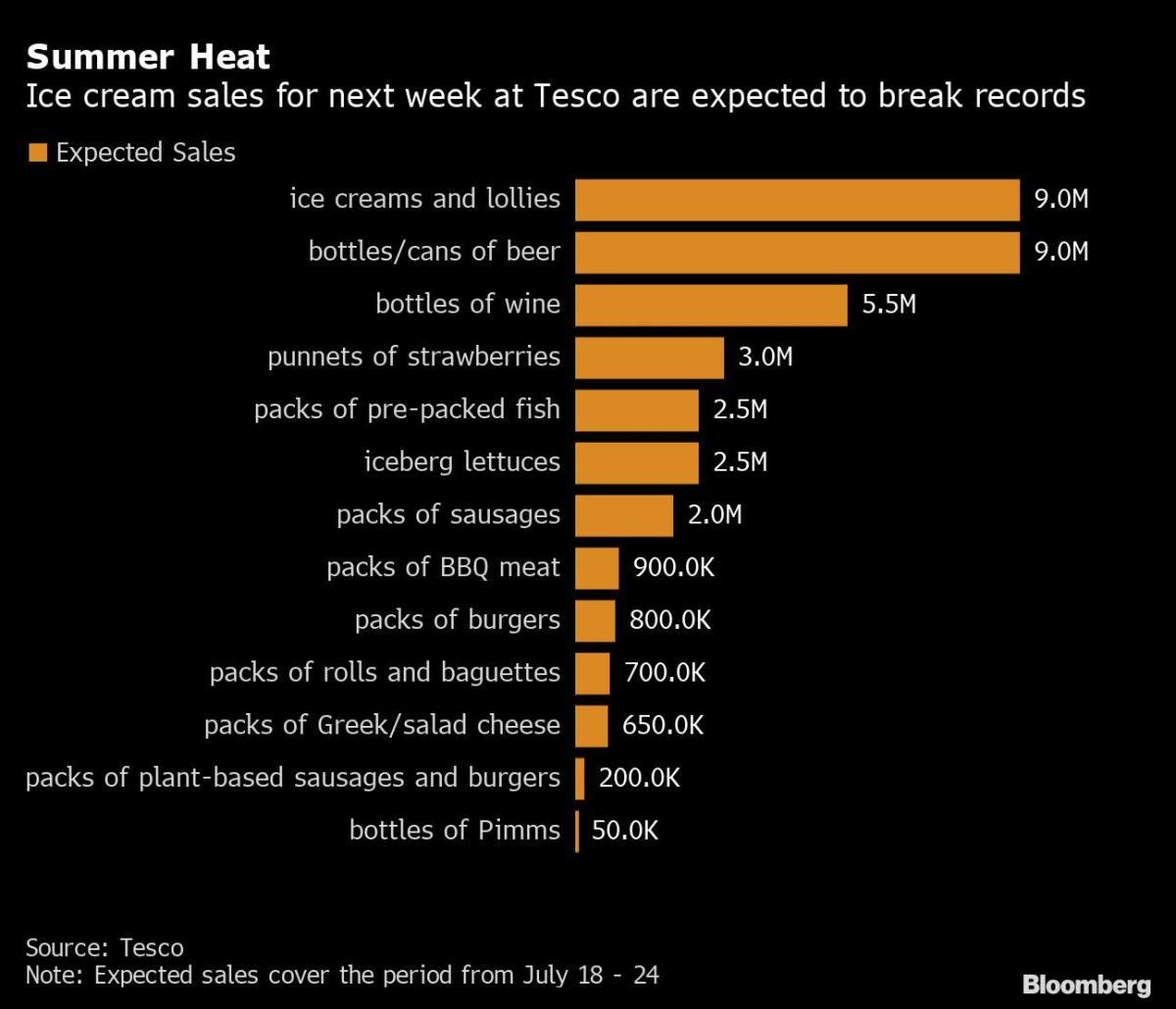
(Bloomberg) —
Most Read from Bloomberg
After strikes, transport disruption, soaring inflation, a jump in Covid-19 infections and even the resignation of its prime minister, now the sweltering summer is about to add to the havoc in the UK.
The Met Office issued its most severe warning for next week, with temperatures set to rise above 35 degrees Celsius (95 Fahrenheit) in parts of England, including London, and might hit national records exceeding 40 degrees. The red alert, with potential power outages, canceled flights and a danger to life, was triggered for the first time and is in place for Monday and Tuesday.
The government held an emergency Cobra meeting on Saturday, chaired by Chancellor of the Duchy of Lancaster Kit Malthouse rather than Prime Minister Boris Johnson, to work out contingency plans for the nation’s schools, emergency services and transport networks. Ministers will meet again Monday.It all adds to the chaos in a nation that’s grappling with messy politics and a wilting economy. While supermarkets expect ice cream sales to reach records and coastal resorts to welcome throngs of people, the custodians of the UK’s infrastructure are flagging the worst-case scenarios.
The electricity network is straining under the heat and as cooling systems ramp up, a lack of wind is reducing supplies. The railway network, which in the past has seen cables snap and tracks buckle, is reducing speed on services. The National Health Service is concerned hospitals that are already overwhelmed will see a spike in patients suffering from the heat.
“In this country, we’re used to treating a hot spell as a chance to go and play in in the sun,” said Penny Endersby, the Met Office’s chief executive officer. “This is not that sort of weather.”
Searing temperatures across Europe have crippled agriculture in France, forced Spain to cut water supply in some regions and triggered a state of emergency in parts of Italy. But while more drastic this year, increasingly hot summers aren’t as unusual as they are in Britain. Greece, for example, regularly experiences deadly wildfires.
Read More: Europe Is Frying in Devastating Heat, Yet Is Burning More Coal
Weather-watchers in the UK have been more focused of late on how cold it might get in winter with energy bills due to jump again in October and exacerbating an already painful cost-of-living crisis.
The UK had taken a break from images of cancelled trains, hours-long lines at airports and missing luggage to watch Johnson announce his resignation following a series of scandals involving his conduct. The news this week has been dominated by the race to replace him — but also the weather.
The latest warning is an escalation from forecasts in recent days, when the Met Office expected next week’s temperatures would likely reach the mid- to high- 30s.
The heat is set to put added strain on a UK energy system that’s already under pressure from soaring natural gas prices. London office buildings will be ramping up electricity demand to keep workers cool. That could increase the load on some grid infrastructure that’s not able to transmit as much power when ambient temperatures rise.Britain’s network is designed for extreme temperatures but operators in the areas affected by the Met Office’s red warning have escalated preparations for the heatwave, according to the industry lobby group.
On the generation side, the high-pressure system that’s bringing the heat also creates low winds that sap Britain of one of its biggest sources of cheap energy. Wind farms are set to generate less than 2 gigawatts of power on Monday, leaving the electricity grid more reliant on expensive natural gas. Solar will help lighten the burden, but the UK’s fleet of farms is much smaller than its wind power potential.
“Our services and infrastructure are designed to cope with ‘normal’ weather, and many organizations have plans in place to deal with what they think of as ‘extreme’ conditions,” said Nigel Arnell, professor of climate system science at the University of Reading. “However, we’re seeing more and more examples of extremes, and we’ve also seen evidence that we’re not as well prepared as we thought.”
When it comes to transportation, Britain already faces a summer of train chaos, with several labor unions planning July walkouts over pay and conditions after travel across the country was previously halted in June.
Now Network Rail is warning of severe disruption on Monday and Tuesday, with blanket speed restrictions due to be put in place in England and Wales between 12 p.m. and 8 p.m. on both days, according to a spokesman. The rail network advises people only to travel if necessary.
London’s transport authority said that while it has hot weather plan in to protect its network and keep services running, temporary speed restrictions will be introduced on parts of its network on Monday and Tuesday as a precaution. The measures will likely result in a reduced service and delays.
“Due to the exceptionally hot weather that is expected next week, customers should only use London’s transport network for essential journeys,” TfL Chief Operating Officer Andy Loard said in a statement.
Drivers are being warned to take water to stay hydrated and to allow more time for travel. National Highways, though, said the nation’s motorways and main roads are built to endure extreme weather, including the heat.
The acute strain could be felt in the NHS. The health system is already under pressure with a huge backlog of patients awaiting treatment that was delayed during the pandemic lockdowns. Staff shortages are also pushing up wait times in accident and emergency wards while ambulance response times have also gotten significantly worse.
The situation will be aggravated by a new wave of Covid cases, driven by highly contagious omicron subvariants. Nearly 1 in 19 people in England tested positive in the week ending July 6, according to the latest Office for National Statistics data published on Friday. That was up from 1 in 25 the week before, and the surge is pushing up hospitalizations.
A heatwave will only make the situation worse as people seek treatment for heat stroke. Staff in emergency wards also typically have to treat more drink-related injuries as people socialize and consume alcohol in the warm weather.
Indeed, there’s pressure on retailers too, though more to keep the nation in supply of its summer quenchers.
Supermarket chain Tesco Plc expects to sell more than 9 million ice creams and lollies in the coming week, a record. The supermarket also expects to sell 9 million bottles and cans of beer and 50,000 bottles of Pimms, the classic British summer gin-based fruit drink.
One beer producer, though, is facing labor issues rather than an ability to meet demand. Staff at Budweiser’s site in northwest England will are planning a walkout over pay on Saturday and Tuesday, according to the union. “This strike is the last thing anyone wants – a beer drought in the middle of a heatwave is no one’s idea of fun,” Stephen Boden, organizer at the GMB union, said in a statement.
The good news is that the sizzling heat is usually short-lived, at least that’s what farmers are counting on, according to Jack Ward, chief executive of the British Growers Association. That said, the impact of low rainfall is also being felt like elsewhere on the continent.
Peas, lettuce and apples are particularly susceptible, he said, and crops can’t be shielded. “It’s not catastrophic — it happens,” said Ward. “Extreme heat is uncomfortable for people and plants. But if it doesn’t go on for too long it will have an impact, but we’ll get through it.”
(Adds details on Saturday’s Cobra meeting)
Most Read from Bloomberg Businessweek
©2022 Bloomberg L.P.




